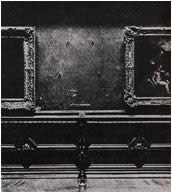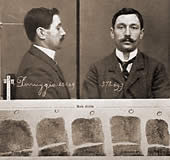On December 10th, 1913, a moustachioed young man called in to see Alfredo Geri, an antiques dealer on the Via Borgognissanti in Florence. He introduced himself as Vincenzo Leonard and offered the astonished dealer a simple trade – for five hundred thousand lire and a guarantee that the painting would never be returned to France, he would hand over the Mona Lisa.
Geri called Giovanne Poggi, the Director of the Uffizi Gallery, and together they accompanied the stranger back to his room at the Hotel Tripoli. As they stood watching, the man opened a trunk and from a secret compartment removed an object wrapped in red cloth.
It was the Mona Lisa. After two years on the run after her daring theft from the Louvre, she had returned.
The theft is discovered

On the morning of 22 August, 1911, Louis Béroud, a Parisian artist who made his living by copying famous paintings for the tourist market, arrived at the Salon Carré in the Louvre to paint the Mona Lisa. To his surprise and annoyance, he found only a bare wall and four iron pegs where the painting usually hung.
Béroud’s concern was dismissed by the guard – the Louvre had recently installed a photo studio and he guessed it was being photographed again or perhaps even having its frame repaired. Béroud waited a few hours until, growing impatient, he bribed the guard to go and see how long the photographer was planning to be. The guard disappeared up to the studio and then returned a few minutes later looking pale.
The painting wasn’t there. Moreover, since the museum had been shut the previous day, no-one had seen it since Sunday. It had been stolen.
The hunt is on
The Section Chief of the Louvre immediately made a frantic call to the Captain of the Guards, who informed the Curator, who telephoned the Prefect of Police, who in term alerted the Sûreté. By early afternoon, the museum has been sealed and sixty detectives and more than one hundred uniformed officers were interrogating everyone in the building and carrying out room by room searches. It took them a week to cover the Louvre’s forty nine acres of galleries, store-rooms, broom cupboards and cellars.
The borders were sealed and every ship and train leaving and entering the country subjected to a rigorous examination. But there was no sign of the Mona Lisa. Nor did the search of the Louvre yield anything beyond the discovery of the empty frame on a service staircase. And even though a left thumbprint print was found on the glass, it was soon proved useless – finger printing was a relatively recent advance, and at that time they only kept right hand prints on file!
Rumours and repercussions
News of the theft spread like wildfire, first across Paris and then around the world. The initial reaction was denial – many believed it must be some sort of a joke. When the Louvre reopened a week after the theft, thousands of Parisians filed through the Salon Carré like mourners at a funeral, just to see the bare iron pegs.
But denial soon turned to anger, and the rumour mill began to grind. Some speculated that the crime was commissioned by an American millionaire determined to secure a trophy asset at any price and by any means. Others saw the dead hand of international politics at work, with the Germans in particular (this was only a few years before the outbreak of World War I) suspected of a plot to discredit France and cause panic and embarrassment. Some even accused the Louvre administrators themselves of staging the theft to boost attendance levels. The French poet Guillaume Apollinaire, who had once called for the Louvre to be “burnt down,” came under immediate suspicion and was arrested. He in turn pointed the finger at Pablo Picasso – both men were questioned and then released.
As the rumours grew, so did the finger pointing. A senior Louvre director was dismissed; other staff were subjected to questioning and vilified. The police took to blaming the Louvre for its inadequate security, the Louvre, in turn, ridiculed their failure to turn up a single lead. With the pressure mounting, the different French law enforcement agencies took to bickering amongst themselves, with one department arresting another department’s informers to hamper their operations.
Rewards were offered – 25,000 francs by the Louvre; 40,000 francs by the magazine L’Illustration. In desperation, the newspaper, Le Matin, even offered 5,000 francs to clairvoyants and fortune tellers to divine the painting’s whereabouts using their contacts in the spirit world.
A theory emerges
In the background, the Prefect of the Paris Police, Inspector Louis Lepine, was slowly piecing together a reconstruction of the theft based on interviews with museum staff, past and present, and the fragments of physical evidence found at the scene.
According to him, the thief must have posed as a tourist on the Sunday and then hidden overnight in a store room, knowing that the next day was Monday, maintenance day, and that the Louvre would therefore be closed to the public. After waiting for the guard in the Salon Carré to go out for his morning cigarette break, he left his hiding place dressed in a workman’s tunic and simply unhooked the Mona Lisa from the wall. Taking it to a nearby service staircase, he removed it from its bulky frame which he hid in a dimly lit corner of the stairwell (where it was later recovered).
Tucking the small panel under his tunic, he made his way down to a door that gave onto an inner courtyard, where he followed a plumber out through a locked door. The thief then waited until the workman had turned a corner, before slipping past a dozing security guard in Cour Visconti and emerging onto the street where he simply melted away.
The Argentinean connection
What Lepine wasn’t to know was that the theft was the brainchild of an Argentinean conman called Eduardo de Valfierno (he claimed to be a marquis), who famously once sold the Eiffel Tower as scrap metal to a gullible French businessman.
Valfierno’s idea was simple and yet brilliant. He had teamed up with a French art restorer and forger called Yves Chaudron and commissioned six copies of the Mona Lisa from him. He then hired former Louvre employee and petty criminal Vincenzo Peruggia to carry out the actual theft, in order to convince his buyers that they were buying the real thing. As soon as the theft was made public, Valfierno sold his copies and never contacted Peruggia again.
Two years later…
For two long years, nothing was seen or heard of the Mona Lisa and fears grew that the painting had been destroyed. But the whole time, the painting was less than a mile from the Louvre, hidden under Peruggia’s stove.

Having finally run out of patience, Peruggia travelled to Florence and, as already described, visited the offices of Alfredo Geri, an antique dealer on the Via Borgognissanti. He introduced himself as Vincenzo Leonard, a patriot who wished to restore the Mona Lisa to the country of her birth as compensation for the humiliation and looting of Italy by Napoleon over a hundred years previously. All he asked was a reward of five hundred thousand lire, and an assurance that the painting would never be returned to France.
Together with Giovanne Poggi, the Director of the Uffizi Gallery,” Geri went to view the painting which had been hidden in the false bottom of Peruggia’s trunk at the Hotel Tripoli. Recognizing the official Louvre museum seals on the back of the panel, Poggi told Leonard that the painting would have to be examined back at the Uffizi – Leonard agreed to wait for them in his room. Back at the Uffizi Poggi soon confirmed its authenticity and called the police who found Peruggia patiently waiting in his hotel room.
A triumphant return
For the next two months, the Mona Lisa toured through the major cities of her homeland, including Rome and Milan, where sixty thousand Italians crowded into the Brera museum for final farewell.
She was then carefully packaged for the return trip to France, escorted by a convoy of politicians, museum officials and policemen. On arrival at the Louvre, she was subjected to another battery of tests, including x-rays and a painstaking photographic analysis of the tiny cracks in the painting’s varnish. Thankfully, no lasting damage had been done and on Sunday, January 4th, 1914, the Mona Lisa was ceremoniously restored to her rightful place in the Salon Carré.
Perugia, meanwhile, was brought to trial in Florence and sentenced to a year and two weeks in prison. He eventually died in 1947.
Neither Valfierno or Chaudron were ever caught.




